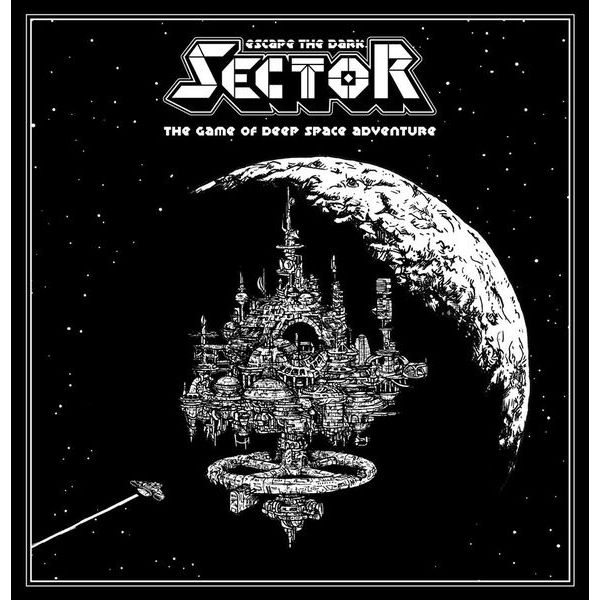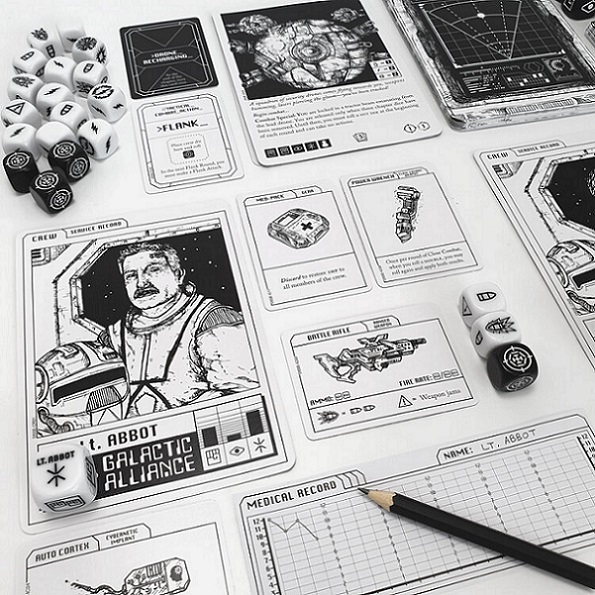Escape the Dark Sector: A Rules-Light RPG Gaming Experience

Trapped on a space station filled with enemies and threats, you break your way out of the detention center and must make your way through the station to find your ship.
Escape the Dark Sector, a standalone sequel to Escape the Dark Castle by Themeborne, takes the core mechanics of the original and adds some new twists to the gameplay and combat.
Gameplay
To set up the game, create the chapter deck by dealing one of the boss cards face-down, then four act three chapter cards (also face-down) on top of it. You do the same for act two and act one chapter cards, and finally top the deck with one of the three start cards. Each player then chooses a hero to play. Each hero comes with one die, which is more or less likely to roll each of the three different traits (might, cunning, and wisdom). Each hero also starts the game with a starting cybernetic card, which grants them a special ability they can use throughout the game, and a sheet to track their health. Everyone starts the game with twelve hit points.
During the game, players decide which character will flip over the next chapter card. Some cards can affect the character that reveals the card, so you want to choose carefully. The newly revealed card is then read aloud and players follow any instructions on the card or initiate combat if it is an enemy (some enemies can be evaded if you choose but there may be a penalty such as taking damage or losing items). Some cards may present you with choices or have you attempt to roll a certain result on your hero die.
Players will gain item cards from defeating enemies and from certain chapter cards. Each player may hold two-to-four items depending on the size of the items.
When entering combat, you place story dice below the enemy card, rotating them to the faces that the card calls for. These faces will match the three symbols you can roll on your hero die. Typically, you will also have to roll some additional story dice based on player count and place these below the enemy card as well.
In each round of combat, players decide their actions first and then perform them simultaneously. There is ranged combat and close combat. Often the enemy card will let you choose which to start with, but sometimes it will tell you. If you start in range combat, players can move into close combat but you can never go the other way around. If at least one player does not use the shoot action during ranged combat you automatically move into close combat for the next round of actions.
During range combat, you have two special actions that you cannot take in close combat: shoot and flank. If players have a gun card, they can take the shoot action. Each gun card has one of three types of ammo and when a gun is loaded you place the matching ammo dice on the item card. When shooting you roll a number of these dice as determined by the fire rate shown on the gun’s card. The enemy card shows what you have to roll to hit based on the type of ammo you are rolling and how much damage it will inflict if it hits. Any ammo dice you rolled are discarded. While shooting you also roll an enemy hit die. If you roll a hit, you take damage equal to the amount shown on the enemy card for ranged attacks. For each point of damage you inflict on the enemy, you remove one of its story dice.
One player can flank once during the ranged combat. When you flank you roll a hit die to see if you take damage from an enemy’s ranged attack. Before the next round of actions, you will then get a special flank action in which you roll to attack, removing an extra story die in addition to any damage you cause and the enemy does not retaliate.
During close combat, players cannot use their guns. They may, and at least one player must, take the fight action. When fighting, you roll your hero die and if you roll a result that matches one of the enemy’s current story dice, you remove it. Your hero die can roll some doubles in which case you can remove two matching story dice if there are two currently present beneath the enemy card. These doubles also are surrounded by a shield symbol, which protects you from the enemy’s counter attack. If you do not roll a shield then after your attack the enemy hits you back, dealing damage equal to the amount shown on its card for close combat.
Alternative actions you can take during either type of combat is activate the drone (this can only be done once per fight and heals one player one hit point), reload your weapon (you move ammo dice onto one of your gun cards), trade (you may take an item card from another player), or you may pass your turn.
If you defeat the enemy, players typically get to draw a certain number of item cards and exchange them among themselves, discarding any they do not want or do not have room for. Each player may also take the reload action once between chapter cards.
Players lose the game if any character ever reaches zero hit points. They win the game if they make their way through all the chapter cards and defeat the final boss.

Review
Escape the Dark Sector is a wonderful, streamlined, light and casual RPG experience. Its randomized story keeps the game unpredictable but still manages to come together in neat ways that feel cohesive and can lead to some fun story moments. Each act of story cards represents a different section of the space station, leading to variety in types of encounters and enemies. The flavor text on each card is also quite well done and really lends the game a lot of atmosphere, as does the artwork style.
There’s plenty of cooperation in the game, discussing your best options, who should open doors, who should take which actions each combat round, but you still feel like you’re playing your own unique hero. Chapter cards will often give everyone their own decisions to make (does your character try to roll might or wisdom to get around this obstacle?), and your special abilities and items further help to customize your character.
A lot of the gameplay is quite similar to its predecessor, Escape the Dark Castle, which is a good thing. That gameplay made for a unique game that struck a great balance between light rules and dungeon crawl. The combat is where the game diverges the most; with the ranged vs. close combat, and a couple of new action options. This gives the game a little more depth and it fits well thematically. It does, however, make the game more complicated, with a few more rules to try to remember in the heat of the moment. These additions can give players more feeling of having control over events and the outcome of battle, but does mean it’s going to take a little extra time to learn and teach.
The components are excellent — the chapter cards are nice and large, and the hero and story dice are big and chunky. The health tracking system has also being improved from the previous game in the series: still tracked with pencil and pad, you no longer have to write the numbers but instead draw a line on a graph which is faster and more convenient, and its fun to see the way the line goes up and down as the game progresses.
Escape the Dark Sector is a lot of fun. Its theme is familiar while still feeling like the designers have put their own spin on it. It’s challenging enough to feel like an accomplishment when you win, and victories are always close. If you are looking for a casual role playing experience you absolutely should check this one out.
Pros: Component quality, atmospheric story, player choice
Cons: More complicated to learn than its predecessor
Disclosure: we received a complimentary review copy of this game.






